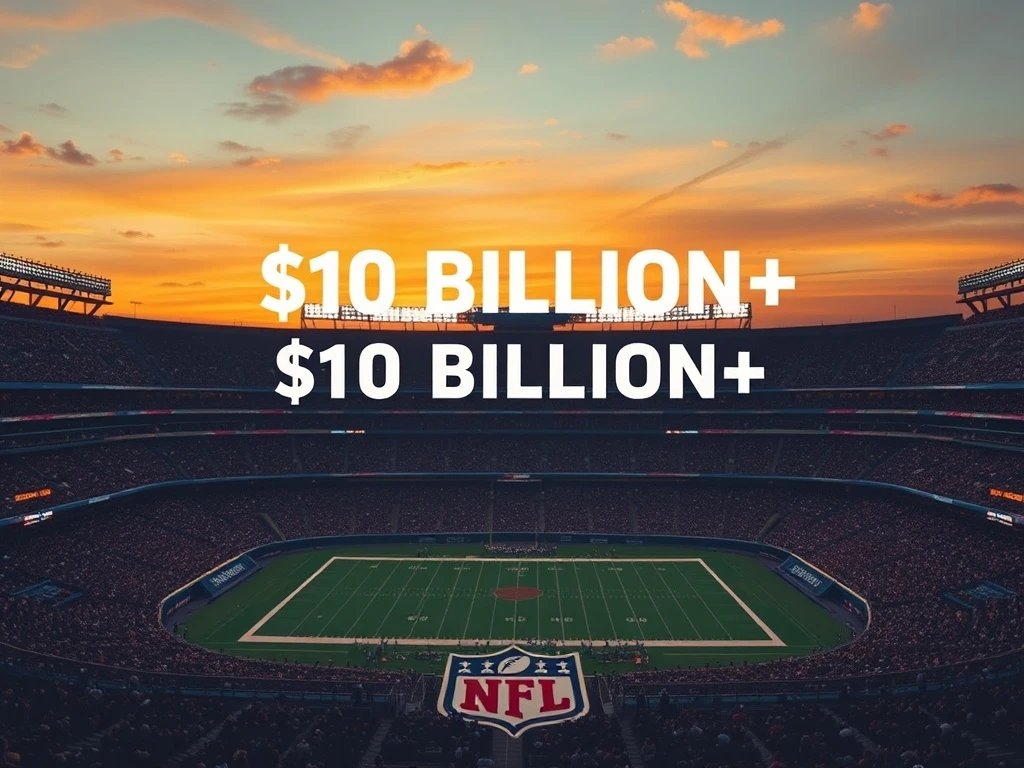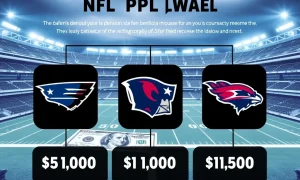The landscape of professional sports finance has undergone a profound transformation. Specifically, the world of American football now witnesses astounding financial benchmarks. Indeed, **NFL team valuations** have reached unprecedented levels. This remarkable surge captures the attention of investors and sports enthusiasts alike. Three franchises now stand out, each valued at over $10 billion. This financial milestone reflects a league with immense economic power and enduring cultural significance.
The Billion-Dollar Benchmark: NFL Team Valuations Soar
Recent reports confirm a groundbreaking development in sports economics. Three prominent NFL franchises have crossed the extraordinary $10 billion valuation mark. This places them among the most valuable sports entities globally. These teams are the Dallas Cowboys, the New England Patriots, and the Los Angeles Rams. Their ascent underscores the robust financial health and growing appeal of the National Football League. For instance, the Dallas Cowboys consistently rank as the world’s most valuable sports team. This team demonstrates the immense potential for growth within the league. Furthermore, the Patriots and Rams also show substantial financial strength. Their valuations reflect strategic management, strong fan bases, and lucrative market opportunities.
The $10 billion threshold represents more than just a number. It signifies the NFL’s dominance in the entertainment industry. Moreover, it highlights the increasing value of scarcity in a league with a limited number of franchises. Owners often view these teams as generational assets. Consequently, they command premium prices. The demand for ownership stakes continues to outpace supply. This dynamic further drives **NFL team valuations** upward. Truly, these valuations showcase the league’s unparalleled market position.
A Look Back: The Humble Beginnings of NFL Franchises
The current astronomical valuations stand in stark contrast to the league’s humble origins. Many early NFL franchises began with minimal capital. For example, some historical accounts suggest certain teams were founded for as little as $500. This figure highlights the incredible financial journey of the NFL. It underscores the monumental transformation the league has undergone. Early teams operated on shoestring budgets. Players often held other jobs. Stadiums were basic, and media coverage was limited. Compare that to today’s multi-billion dollar enterprises. This evolution is truly astounding. It shows how far the NFL has come from its grassroots beginnings. Therefore, understanding this historical context provides perspective on today’s massive **NFL team valuations**.
Early owners faced significant challenges. They relied on local support and passionate fan bases. Success was built on grit and community involvement. The league slowly gained traction over decades. Key moments, like the merger of the NFL and AFL, solidified its position. Landmark media deals followed. These agreements paved the way for unprecedented financial growth. Consequently, the league matured into the powerhouse it is today. This historical progression is crucial to understanding the present-day financial might of NFL franchises.
Driving Forces Behind Exploding NFL Team Valuations
Several key factors contribute to the rapid increase in **NFL team valuations**. These elements create a powerful economic engine. Each plays a vital role in the league’s financial success. Understanding these drivers helps explain the current market dynamics.
- Massive Media Rights Deals: Television and streaming contracts represent the largest revenue stream. The NFL secures multi-billion dollar agreements with major networks and digital platforms. These deals ensure vast reach and significant income for all teams. For instance, recent agreements with Amazon, CBS, ESPN, Fox, and NBC are worth tens of billions of dollars. This guaranteed revenue stream provides financial stability. It also boosts overall team worth. Therefore, media rights are paramount to rising **NFL team valuations**.
- Robust Stadium Revenue and Fan Experience: Modern stadiums are revenue-generating machines. They offer premium seating, luxury suites, and diverse concession options. Teams also host concerts and other events. Ticket sales remain a significant income source. Furthermore, the in-person fan experience drives attendance. Teams invest heavily in state-of-the-art facilities. These investments enhance fan engagement and increase revenue streams. Consequently, the stadium experience directly impacts a team’s financial performance.
- Lucrative Sponsorships and Merchandise Sales: Corporate sponsorships provide substantial income. Brands pay millions to associate with NFL teams and the league itself. These partnerships extend across various industries. Apparel and merchandise sales also contribute significantly. Fans eagerly purchase jerseys, hats, and other team gear. This creates a powerful brand identity. It also generates consistent revenue. These commercial avenues bolster the financial health of each franchise.
The Scarcity Principle and Global Appeal
The limited number of NFL franchises enhances their value. Only 32 teams exist. There is no immediate plan for expansion. This scarcity drives up demand among potential buyers. Ownership of an NFL team is an exclusive club. It offers prestige and a unique business opportunity. Consequently, this exclusivity contributes to higher **NFL team valuations**. The rarity of these assets makes them highly desirable investments.
Moreover, the NFL’s global appeal continues to expand. Games are broadcast worldwide. The league hosts international games in London and Germany. This global reach attracts new fans and sponsors. It opens up new markets for merchandise and media consumption. As the international fan base grows, so does the league’s overall value. This global expansion further solidifies the financial strength of NFL franchises.
Economic Impact Beyond the Field
NFL teams contribute significantly to local economies. Their presence generates substantial economic activity. This impact extends far beyond game days. Consider these key areas:
- Job Creation: Teams employ thousands of people. This includes players, coaches, administrative staff, and stadium workers. Indirect jobs also arise in hospitality, transportation, and retail sectors. The economic ripple effect is considerable.
- Tourism and Local Spending: Home games draw visitors from other cities and states. These fans spend money on hotels, restaurants, and local businesses. This influx of tourism boosts local economies significantly. It provides a consistent revenue stream for host cities.
- Infrastructure Development: New stadiums and training facilities often involve massive construction projects. These projects create jobs and stimulate local development. They can revitalize urban areas. Such investments also enhance the city’s overall infrastructure.
The economic footprint of NFL teams is undeniable. Their operations create a robust ecosystem of related businesses and services. This contributes to the overall prosperity of their home regions. Therefore, the value of an NFL franchise extends beyond its direct financial worth. It encompasses its broader societal and economic contributions.
Future Trajectories for NFL Team Valuations
The future outlook for **NFL team valuations** appears robust. The league constantly explores new revenue streams. Sports betting partnerships are expanding rapidly. This opens up a massive new market. Digital engagement and innovative fan experiences are also priorities. The league leverages technology to connect with fans. Virtual reality and interactive platforms offer new possibilities. Furthermore, the continued growth of global markets promises additional revenue. The NFL remains proactive in its pursuit of new opportunities.
However, challenges also exist. Rising player salaries represent a significant cost. Competition from other entertainment options remains fierce. Maintaining fan engagement requires constant innovation. Nevertheless, the NFL’s strong brand and loyal fan base provide a solid foundation. Its adaptability and business acumen suggest continued financial success. Experts predict further increases in team values. The $10 billion mark may soon become a more common valuation.
In conclusion, the surge in **NFL team valuations** reflects a powerful combination of factors. These include massive media deals, robust stadium revenues, and strategic global expansion. The league’s journey from humble beginnings to multi-billion dollar enterprises is remarkable. As the NFL continues to innovate and expand its reach, its financial future appears exceptionally bright. This ongoing growth solidifies its position as a dominant force in sports and entertainment.
Frequently Asked Questions (FAQs)
What factors contribute most to high NFL team valuations?
Several key factors drive high NFL team valuations. Media rights deals, worth billions of dollars, provide the largest revenue stream. Stadium revenues from ticket sales, luxury suites, and concessions also contribute significantly. Furthermore, corporate sponsorships, merchandise sales, and the league’s overall brand strength play crucial roles. The scarcity of NFL franchises also boosts their value.
Which NFL teams are currently valued over $10 billion?
As of recent reports, three NFL teams have surpassed the $10 billion valuation mark. These franchises are the Dallas Cowboys, the New England Patriots, and the Los Angeles Rams. These teams consistently rank among the most valuable sports organizations globally, reflecting their strong financial performance and market appeal.
How have NFL team valuations changed since the league’s early days?
NFL team valuations have undergone an extraordinary transformation. Early franchises were often founded with minimal capital, sometimes as little as a few hundred dollars. Today, teams are valued in the billions. This dramatic increase reflects the league’s growth in popularity, the expansion of media rights, and the professionalization of sports business operations over many decades.
Do NFL team valuations impact local economies?
Yes, NFL team valuations significantly impact local economies. Teams generate revenue through ticket sales, merchandise, and concessions, boosting local businesses. They also create thousands of jobs, both directly within the organization and indirectly in related sectors like hospitality and transportation. Additionally, new stadium developments often spur infrastructure improvements and urban revitalization.
What is the future outlook for NFL team valuations?
The future outlook for NFL team valuations appears positive. The league continues to explore new revenue streams, such as sports betting partnerships and advanced digital engagement. Global expansion also promises new markets and fan bases. While challenges like rising player salaries exist, the NFL’s strong brand and adaptive business strategies suggest continued growth in franchise values.
























